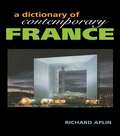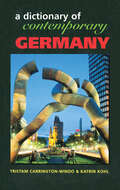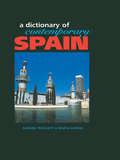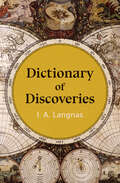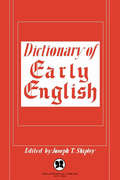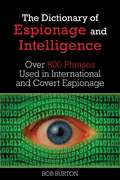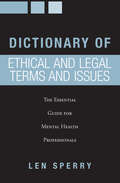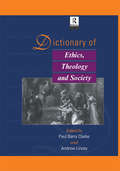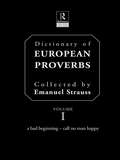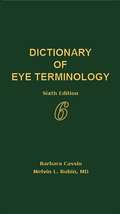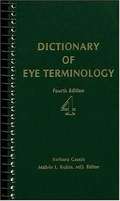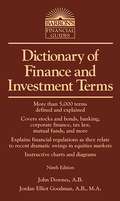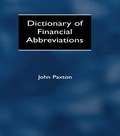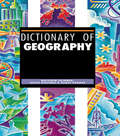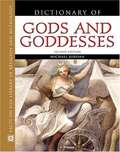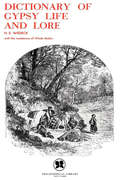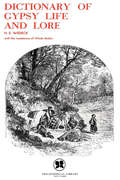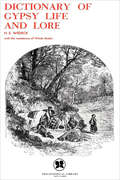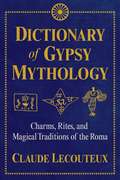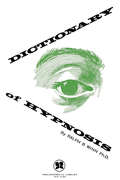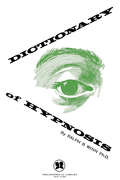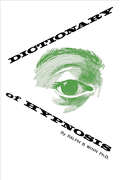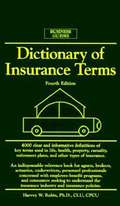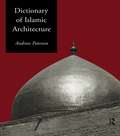- Table View
- List View
Dictionary of Contemporary France (Contemporary Country Dictionaries)
by Richard Aplin Joseph MontchampFirst Published in 1999. Routledge is an imprint of Taylor & Francis, an informa company.
Dictionary of Contemporary Germany (Contemporary Country Dictionaries)
by Katrin Kohl Tristam Carrington-WindoFirst published in 1999. Routledge is an imprint of Taylor & Francis, an informa company.
Dictionary of Contemporary Spain (Contemporary Country Dictionaries)
by Sandra Truscott Maria GarciaFirst published in 1999. Routledge is an imprint of Taylor & Francis, an informa company.
Dictionary of Discoveries
by I. A. LangnasA comprehensive reference volume of significant explorers, pioneers, and conquerors, from the ancient world to the twentieth century. Since the days when Alexander the Great vastly expanded the Hellenistic world, history has been shaped by the urge to discover—and conquer—unknown lands. In Dictionary of Discoveries, I. A. Langnas presents a thoroughly researched record of the major explorers, travelers, conquistadors, colonial officers, and others who contributed to the grand enterprise of discovery. Organized alphabetically, the entries give special focus to the Age of Discovery, a time when European societies embarked on far-reaching campaigns in search of new lands, trading routes, and knowledge. Famous names like Christopher Columbus, Daniel Boone, and Sir Ernest Shackleton are featured alongside lesser-known figures such as Grigori Shelekhov, theeighteenth-century Russian explorer of Alaska and the Kodiak Islands.
Dictionary of Early English
by Joseph T. ShipleyJoseph T. Shipley's tome Dictionary of Early English provides an indispensible and unparalleled reference tool on the study of early English. With a preface by Mark Van Doren and an extensive headword list, this dictionary brings to light the terms, concepts, and vocabulary of ancient English. Joseph T. Shipley has written and edited several books, dictionaries, and anthologies including The Origins of English Words, Modern French Poetry, An Anthology, and Dictionary of World Literature.
Dictionary of Espionage and Intelligence: Over 800 Phrases Used in International and Covert Espionage
by Bob Burton W. E. GriffinFrom Bob Burton - a former member of both the civilian and military intelligence communities and America’s most feared bounty hunter - comes the complete lexicon of over 800 terms and meanings used in international and covert espionage. Dictionary of Espionage and Intelligence includes the most up-to-date terminology of special operations from A to Z, including: Breaktime: The time it takes to break down he resistance level of a subject in an interrogation of a brutal nature - usually 5-7 hours Hero Project: A project, operation, or extraction considered too dangerous, with only the most skilled personnel able to pull it off. Cake or Death: An unspoken but soon-realized ultimatum that a prisoner of the spook war understands as his personal fate - cooperate or die.Compiled by a man who knows covert action and clandestine warfare from the inside out, Dictionary of Espionage and Intelligence is a perfect compendium of the secret language spoken by those who fight the silent war.
Dictionary of Ethical and Legal Terms and Issues: The Essential Guide for Mental Health Professionals
by Len SperryThe professional practice of counseling and mental health can often be complex and litigious. While there are many professional ethics textbooks, there are few, if any, supporting resources to assist in mastering basic terminology, or to offer easy access to important legal opinions in everyday practice. The Dictionary of Ethical and Legal Terms and Issues is an invaluable resource for students and practitioners alike who need to navigate that complexity. The book blends ethical, legal, and professional issues along with a dictionary for the mental health professional in one handy volume. An essential resource in any professional library, this book will be of interest to anyone who needs a ready guide to the myriad ethical and legal terms and issues encountered in both training and practice.
Dictionary of Ethics, Theology and Society
by Andrew Linzey Paul A. ClarkeThis Dictionary provides a unique and groundbreaking survey of both the historical and contemporary interrelations between ethics, theology and society. In over 250 separately-authored entries, a selection of the world's leading scholars from many disciplines and many denominations present their own views on a wide range of topics.Arranged alphabetically, entries cover all aspects of philosophy, theology, ethics, economics, politics and government. Each entry includes:* a concise definition of the term* a description of the principal ideas behind it* analysis of its history, development and contemporary relevance* a detailed bibliography giving the major sources in the fieldThe entire field is prefaced by an editorial introduction outlining its scope and diversity.Selected entries include:Animal Rights * Capital Punishment * Communism * Domestic Violence * Ethics * Evil * Government * Homophobia * Humanism * Liberation Theology * Politics * Pornography * Racism * Sexism * Society * Vivisection * Women's Ordination
Dictionary of European Proverbs
by Emanuel StraussThis Dictionary contains over 50,000 proverbs, in some 70 European languages and dialects, arranged in 2,500 sets. It is the fruits of over 40 years of collection and research, the only collection of proverbs on anything like this scale ever to be published anywhere in the world. Emanuel Strauss has trawled through innumerable collections of proverbs in all languages, from early printed books and rare items to the latest theses and journals, and grouped together many thousands of proverbs in sets of equivalent meaning. Comprehensive indexes for each language provide access to any proverb by way of its key words. A critical bibliography musters some 500 items, from incunabula to the current decade.
Dictionary of Eye Terminology
by Barbara Cassin Melvin L. RubinThis new edition has been expanded with more terms and more abbreviations. Here are more than 5,000 of the most frequently used terms and phrases associated with the eye and vision, and 1,000 abbreviations and acronyms. Definitions are in "plain English" so everyone can understand them. SPECIAL FEATURES include mini-definitions within definitions (you don't need to chase down a cross-reference), phonetic pronunciations, and actual misspellings in the alphabetical listings, so you don't need to spell a word correctly to find it.
Dictionary of Eye Terminology, 4th Edition
by Barbara Cassin Melvin L RubinThis comprehensive reference has been written for the purpose of making ophthalmological terminology comprehensible to the person without a scientific background.
Dictionary of Finance and Investment Terms (Barron's Business Dictionaries)
by Jordan Goodman John DownesMore than 5,000 terms related to stocks, bonds, mutual funds, banking, tax laws, and transactions in the various financial markets are presented alphabetically with descriptions. The new ninth edition has been updated to take account of new financial regulations and recent dramatic swings in equities, credit, and other financial developments. Readers will also find a list of financial abbreviations and acronyms, as well as illustrative diagrams and charts. Here’s a valuable, thorough dictionary for business students, financial professionals, or private investors.
Dictionary of Finance and Investment Terms: More Than 5,000 Terms Defined and Explained (Barron's Business Dictionaries)
by John Downes Jordan Elliot GoodmanMore than 5,000 terms related to stocks, bonds, mutual funds, banking, tax laws, and transactions in the various financial markets are presented alphabetically with descriptions. The new tenth edition has been updated to take account of new financial regulations and recent dramatic swings in equities, credit, and other financial developments, including the Tax Cuts and Jobs Act of 2017. Readers will also find a list of financial abbreviations and acronyms, as well as illustrative diagrams and charts. Here's a valuable, thorough dictionary for business students, financial professionals, or private investors. Titles in the Pocket-size Book series were compiled and written by recognized authorities in their fields. Like all titles in the series, this book lists and defines several thousand specialized terms alphabetically.
Dictionary of Financial Abbreviations
by John PaxtonFirst Published in 2003. Routledge is an imprint of Taylor & Francis, an informa company.
Dictionary of Geography
by David Redfern Malcolm Skinner Geoff FarmerGeography as a subject covers a very wide range of topics, and the concepts are constantly being updated and revised. Dictionary if Geography , designed to aid understanding of a sometimes complex field, is an A-Z guide to key geographical terms. Each entry begins with a clear, one-sentence definition and is then developed in line with the relative importance of the concept covered, often through the use of worked examples and illustrations. Entries are carefully cross-referenced.
Dictionary of Gods and Goddesses
by Michael JordanA television journalist and specialist on the anthropology of religions, Jordan addressed his 1993 first edition to students and travelers, describing deities likely to be encountered in studying western civilization and visiting common Asian tourist sites. Here he accounts for a broadening of interest in cultures of the southern hemisphere and some of the less mainstream aspects of European history. For well known deities of past times, he includes such information as origin, known period of worship, centers of cult, art references, and literary sources. Cross-references are abundant, and he includes peripheral mentions (indented) in the index.
Dictionary of Gypsy Life and Lore
by Wade Baskin Harry E WedeckThrough the centuries, Gypsies all over the world have been misunderstood, maligned, rejected. Outcasts of the countries in which they live, they have wandered for centuries over the face of the earth. They have no homeland, no political unity, no recognition among nations. They have been alone, sundered, shunned, persecuted and banished. Until about a century ago, their original home had been a matter of dispute. Their language had been a source of puzzlement. Yet their conduct and their traditions, their feeling for music, dance and song, have all been acclaimed. Still they were not accepted and were forced to remain apart from conventional society. Here is their epic history, with its folktales and beliefs, its rites and customs. Here is the vast treasury of the Gypsies.
Dictionary of Gypsy Life and Lore
by Harry E. WedeckThrough the centuries the Gypsies all over the world have been misunderstood, maligned, rejected. Outcasts of the countries in which they lived, they have wandered for centuries over the face of the earth. They have no homeland, no political unity, no recognition among nations. They have been alone, sundered, shunned, persecuted and banished. Until about a century ago, their original home has been a matter of dispute. Their language has been a source of puzzlement. Yet their conduct and their traditions, their feeling for music, dance and song, have all been acclaimed. Still they were not accepted and were forced to remain apart from conventional society. Here is their epic history, with its folktales and beliefs, its rites and customs. Here is the vast treasury of the Story of the Gypsies. Illustrated. Harry E. Wedeck was a linguistic, scholar of the classics, and observer of spheres beyond the norm. A native of Sheffield, England, Mr. Wedeck was chairman of the department of classical languages at Erasmus Hall High School in Brooklyn from 1935 to 1950 and then taught the classics at Brooklyn College until 1968. Afterward he lectured on medieval studies at the New School for Social Research, until 1974. Some of his excursions into the unusual remain available in reprint editions. They include Dictionary of Astrology, A Dictionary of Aphrodisiacs, A Treasury of Witchcraft and Triumph of Satan. They were originally written near the end of Mr. Wedeck's career, when he was steeped in the classics as an educator in the New York City school and college system.
Dictionary of Gypsy Life and Lore
by Wade Baskin Harry E. WedeckThis comprehensive reference volume offers in-depth information on one of the world&’s most fascinating and misunderstood cultures. Throughout history, Gypsies all over the world have been maligned and rejected. Outcasts of the countries in which they live, these nomads have wandered for years over the face of the earth. They have no homeland, no political unity, no recognition among nations. In popular folklore, they are vagrants, thieves, tinkerers, and con artists, which is to say, egregiously misunderstood. Until about a century ago, these travelers&’ original home had been a matter of dispute. Their language had been a source of puzzlement. Yet their conduct and their traditions, their feeling for music, dance and song, have all been acclaimed. Harry Wedeck&’s Dictionary of Gypsy Life and Lore sheds much-needed light on the true history and culture of the Gypsies, separating fact from fiction while celebrating their folktales, rites, and customs.
Dictionary of Gypsy Mythology: Charms, Rites, and Magical Traditions of the Roma
by Claude LecouteuxA comprehensive A-to-Z reconstruction of the oral tradition of the Rom--gypsies--based on sources never before available in English • Presents the origin myths and magical traditions of the gypsies, including their legendary ties to Egypt, animal ancestors, and tree spirits • Examines the three major settings of gypsy folktales--the forest, the waters, and the mountain--and shows how their world is full of spirits • Shows how the religious concepts of the Rom testify to a profound syncretism of the pagan traditions and Christianity Although their own myths and their common name point to Egyptian origins for the gypsies, the Rom, as they call themselves, originated in India, as evidenced by studies of their language. They arrived in Europe in the ninth century and spread across the continent from East to West, reaching England in the 15th century and Scandinavia by the end of the 16th century. A nomadic people, these wanderers were reviled by local populaces wherever they went and regarded as misfits, intruders, foreigners, and thieves. Drawing on a number of sources never before available outside of Eastern Europe, Claude Lecouteux reconstructs the gypsy oral tradition to provide a comprehensive A-to-Z look at gypsy mythology, including their folktales, rites, songs, nursery rhymes, jokes, and magical traditions. His main source is material collected by Heinrich Adalbert von Wlislocki (1856-1907), an ethnologist who lived with gypsies in Romania, Transylvania, and Hungary in the latter half of the 19th century. He presents the origin myths of the gypsies, legends which form the ancestral memory of the gypsy tribes and often closely touch on their daily life. Lecouteux explores the full range of supernatural beings that inhabit the gypsy world, including fairies, undines, ogres, giants, dog-people, and demons, and he examines the three major settings of gypsy folktales--the forest, the waters, and the mountain, which they worshiped as a sacred being in its own right. He also reveals how coexisting with peoples of different religions led the gypsies to adapt or borrow stories and figures from these groups, and he shows how the religious concepts and sacred stories of the Rom testify to a profound syncretism of pagan traditions and Christianity. Complete with rare illustrations and information from obscure sources appearing for the first time in English, this detailed reference work represents an excellent resource for scholars and those seeking to reconnect to their forgotten gypsy heritage.
Dictionary of Hypnosis
by PhD Ralph B. WinnSeven editions of Dictionary of Hypnosis were published between 1965 and 2013 in English and held by 183 WorldCat member-libraries worldwide. The first of its kind, this book seeks to enable intelligent persons to read practically anything in the field of hypnosis. It also provides them with a substantial amount of reliable information concerning the history of hypnosis and its various contemporary uses and applications in medicine, psychology and other sciences. Moreover, it is a reference work of enduring value.
Dictionary of Hypnosis
by Ralph B. WinnThe first book of its kind, this volume seeks to enable intelligent persons to read practically anything in the field of hypnosis. It also provides them with a substantial amount of reliable information concerning the history of hypnosis and its various contemporary uses and applications in medicine, psychology and other sciences. Moreover, it is a reference work of enduring value. Dr. Ralph B. Winn, a professor of psychology at Rollins College, is author of twenty volumes, among them Scientific Hypnotism.
Dictionary of Hypnosis: Science And Philosophy, The Psychology And Psychotherapy Of Otto Rank, And Dictionary Of Hypnosis
by Ralph B. WinnA comprehensive A-to-Z guide to the fascinating field of hypnosis, covering its history, concepts, vocabulary, and significant figures. The first of its kind, Dictionary of Hypnosis has been an essential text on the subject since its first publication in 1965. Written by psychology professor and hypnosis expert Dr. Ralph B. Winn, this wide-ranging reference book presents complex scientific concepts in approachable, straightforward language. It also provides a substantial amount of information on the history of hypnosis and its various contemporary uses in medicine, psychology, and other sciences.
Dictionary of Insurance Terms
by Harvey W. RubinBooks in Barron's pocket-sized Business Dictionaries series list thousands of specialized terms alphabetically and present concise definitions. The authors of all books in this series are recognized authorities in their special fields.
Dictionary of Islamic Architecture
by Andrew PetersenThe Dictionary of Islamic Architecture provides the fullest range of artistic, technical, archaeological, cultural and biographical data for the entire geographical and chronological spread of Islamic architecture - from West Africa through the Middle East to Indonesia, and from the seventh to the eighteenth centuries of the Common Era.Over 500 entries are arranged alphabetically and fully cross-referenced and indexed to permit easy access to the text and to link items of related interest.Four main categories of subject matter are explored:* dynastic and regional overviews* individual site descriptions* biographical entries* technical definitionsOver 100 relevant plans, sketch maps, photographs and other illustrations complement and illuminate the entries, and the needs of the reader requiring further information are met by individual entry bibliographies.
